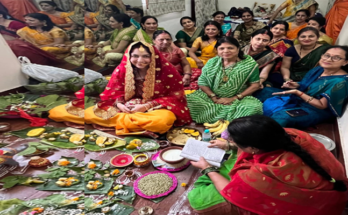 The Kerala Story is an opportunity for all concerned for baking their own bread. The result is divided public opinion, ideological polarisation and a safe-playing silence; a triangular pattern of what India broadly thinks of the movie and the problem highlighted in it. The Central Board of Film Certification (CBFC) has passed it giving ‘A’ certificate. The Supreme Court and the Kerala High Court refused to stay its release. Obviously, the film enjoys the merit of freedom of expression.
The Kerala Story is an opportunity for all concerned for baking their own bread. The result is divided public opinion, ideological polarisation and a safe-playing silence; a triangular pattern of what India broadly thinks of the movie and the problem highlighted in it. The Central Board of Film Certification (CBFC) has passed it giving ‘A’ certificate. The Supreme Court and the Kerala High Court refused to stay its release. Obviously, the film enjoys the merit of freedom of expression.
The theme of the film is about forced conversion, radicalisation and recruitment of women of Kerala, about 32,000 in terror groups of ISIS-ruled Syria. The story has two dimensions- forced marriage and terrorism and has drawn mixed responses in Kerala at different quarters. From Kerala, the theme was first rejected with the statement that nobody joined ISIS from the state. When reports on cases of joining were produced, the criticism shifted to the question of the number of victims claimed in the film. Tharoor reports four women’s requests to bring their daughters back. Metropolitan Archbishop in his pastoral letter has expressed his concerns over growing incidents of love traps for females on Kerala by terrorist organisations. Cases of missing women have been recorded by the National Crimes Records Bureau (NCRB) across the states, US Department of State Report, 2020 and the National Investigation Agency (NIA). The issue is not about the data, but the incidents.
Among the audience, while the film is a must-watch for awareness of youngsters against terrorist ways of wooing them for some, it is an exaggerated version of some isolated incidents for others. For the latter, it is the distortion of facts and figures. Individual voices on Twitter have an appreciation for the film, while a few criticise it as Islamophobic underlying conspiracy theory. The former group endorses it to the extent of being one of the worst human tragedies in modern India to be watched leaving political ideology aside. Even some suggest naming the film a World Story by citing such cases in USA and UK, and the recent concern of Suella Braverman about grooming gangs in the UK to draw attention to instances of Pakistan origin man abusing white English girls. A woman from Kasargod endorses the film as her real-life story. The opponents view it as inflammatory fictional, and an effort to damaging leftist perspective. They question the absence of FIR and the parents of missing women in the film. There are seemingly neutral opinions advising the inclusion of stories of brotherhood. The criticisms, whatever may be the perspective of the argument, keep Muslims at the centre. No doubt, several twitters question Indian Muslims’ objection to ISIS design of recruitment. They do not blame Muslims’ role in recruitment in general, rather see it from the angle of terrorist ploy.
The CM of Kerala criticises it as propaganda of Sangha Parivar with a malign intention of humiliating the state in front of the world. Shashi Tharoor rejects it as ‘gross exaggeration’ and ‘distortion of the Kerala reality’. Similar objections come from Muslim organisations and different political parties. In addition to BJP, Catholic Bishops Council lauds and endorses the movie. Nationalist Youth Congress (NYC), the Youth Organisation of the National Congress Party (NCP), the Fraternity Movement, and the Youth Wing of Welfare Party of India staged protests in Ernakulum alleging false propaganda to divide society while in Thiruvananthapuram, the shows were screened without any protest where BJP sympathisers, local leaders and people with curiosity constituted the audience.
In the film industry, two broad types of responses are noticed. While some oppose the ban on film, others remain silent. In the silent section, few were earlier vocal in different contexts when the ban on some films was demanded. For other sections, silence is the best way of avoiding controversy, showing neutrality and closing eyes to the demand for their opinions. A few from among those who oppose the ban question the authenticity of the figure. Playing safe indeed!
The state-specific allegations surprisingly echo in other states. While the film is not banned in Kerala, by Left Government, despite the allegations, it is banned in West Bengal. In Tamil Nadu, the ban in Multiplexes and Theatres is state-sponsored citing fear, damage of property, and demand from Muslim groups. Producers Guild, however, has strongly objected to this ban. The ban raises questions on the state’s responsibility towards maintenance of law and order, respect to the judiciary, constitutional provisions and institutional sanctity like that of CBFC. The ban also implies that states used the film to create a divide between Hindus and Muslims under the plea of maintaining social harmony. When the film is projected as Hindu or BJP propaganda against Muslims and banned to appease Muslims so that tension is not created, then what makes the government think that the non-Muslim group will not create tension consequent upon the ban? Arguably, it indicates that only Muslims create tension, and the government can manipulate it at its convenience! Besides, it proves that Muslims are one; so when Muslims in Kerala sneeze, the Muslims in other parts will catch cold.
These are some of the questions before us about people’s thinking on The Kerala Story. Is it the new trend in India? History tells us that people used to think beyond political and territorial divisions, or sided or invited enemies for selfish interests. History also tells us that some people remained indifferent to happenings or depended on destiny. But more loudly history echoes the result of indifference or siding the enemy or a wrong cause in terms of our long subjugation under Muslim and colonial rulers.
The controversy and contradictions over the film reflect what people or organisations think. But what they do not think is about the implications of such thinking.
(Written by Professor M. C. Behera, Rajiv Gandhi University I email: mcbehera1959@gmail.com)



